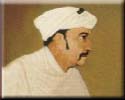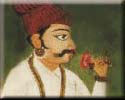The history of Kutch is very old. Traces of the Indus valley civilization (3000 to 1500 B.C.) have been discovered at Dholavira – Kutch. When Alexandra the Great reached these parts in 325 BC Rann was not an arm of the sea. The eastern branch of the Indus emptied itself into the Rann which made it into a fresh water lake.
The Mauryan empire broke of the Gujrat Kutch and Sindh passed under the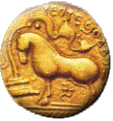 rules of Greeks from Bactria in 140-120 BC. Bactrian rule over Gujrat, Kathiawad and Kutch was ended by Sakas in the 1st Century and ruled upto the 3rd century. After that Samudragupta attacked the Sakas and ended their rule.
rules of Greeks from Bactria in 140-120 BC. Bactrian rule over Gujrat, Kathiawad and Kutch was ended by Sakas in the 1st Century and ruled upto the 3rd century. After that Samudragupta attacked the Sakas and ended their rule.
 rules of Greeks from Bactria in 140-120 BC. Bactrian rule over Gujrat, Kathiawad and Kutch was ended by Sakas in the 1st Century and ruled upto the 3rd century. After that Samudragupta attacked the Sakas and ended their rule.
rules of Greeks from Bactria in 140-120 BC. Bactrian rule over Gujrat, Kathiawad and Kutch was ended by Sakas in the 1st Century and ruled upto the 3rd century. After that Samudragupta attacked the Sakas and ended their rule.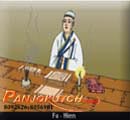 | At the end of the sixth century, the great conqueror king Sahiras of Sindu found Kutch and easy conquest. A Chinese traveller’s evidence shows that Buddhism was in fact declining and Jainism was gaining ground in Kathiawad and Sindh. |
At the end of the seventh century the Arabs conquered Sindh.Samma Rajputs of the hindu clan settled in Kutch. Some of the chiefs also settled in Sindh and were allowed by the Arabs to be independent rulers there. In the early ninth century the chief of that clan was Lakho Ghuraro, who had two wives.
After the death of Lakho Ghuraro his eldest son Unnad succeeded, but Unnad’s step brother Mod and Manai plotted against him and killed him. Later on Mod and Manai conspired to kill their uncle Vagam Chavda and declared themselves the kings of the area. That time Patgadh was under the rule of seven brothers of the Sandh tribe "Seven Sandhs", who threatened to avenge the murder of Vagam. Later on Mod and Manai killed the seven sandhs and became the masters of the city and of its dependant territories.
At that time Dharan Vaghela was a ruler of these areas. Mod made friendship with him and he got his son Sad married to Dharan’s sister. Mod and Manai’s death in the ninth century weakened Sad’s position. Dharan killed Sad and wanted to kill Ful, Sad’s six month old son, but he was saved.
When Ful grew up he challenged his maternal grand father Dharan Vaghela to combat. Dharan Vaghela by now an elderly man preferred to make peace by giving one of his daughters to Ful in marriage. But Ful never forgot that Dharan had murdered his father.
After a few years, Ful killed Dharan. Hearing this, Ful’s wife committed suicide. She was then pregnant and her unborn infant was brought out alive from her dead body. He was named Ghao (born of the wound). After this incident Ful changed his capital to Angorgadh, near Habai. He married his second wife Sonal from the Rabari tribe who gave birth to a son Lakho in 920 A.D.
Lakho Fulani was a powerful king. He was very famous in Kutch and Gujrat. He shifted his capital to Kera and built a fort. He died fighting on his friend Grahripu’s side at Atkot near Rajkot.
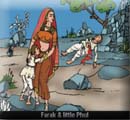 | After Lakho Fulani’s death his nephew Jam Punvaro succeeded to the throne without opposition. He built a fort called Padhargadh near Nakhatrana. However he was so cruel that the people hated him. Punvaro was killed by the Jakhs. After Punvaro’s death the Solankis and Chavdas ruled over Kutch. |
In the middle of the 12th century a Samma prince named Lakho decided to seek his fortune in the Rann of Kutch. This Lakho had been adopted by a childless Samma chief named Jadeja. Lakho arrived in Kutch in 1147 with his twin brother Lakhiar. By then the Chavda power had decayed and they built themselves a new capital Lakhiarwara, about 20 miles from the ruins of Padhargadh.
After Lakho’s death Rato Raydhan came to the throne. Some Jat tribesmen who had come to Kutch before Lakho Lakhiar gave him trouble. With support of the saint Garibnath Rato Raydhan successfully subdued the Jats and made gifts of the Land of the Dhinodhar monastery to Garibnath.
After the death of Raydhan in 1215 his territories were divided between his four sons. Deda, the eldest one was given Kanthkot, Odha the second son remained ruling Lakhiarwara, Gajan was given Bara and the fourth one Hothi was given twelve villages near Punadi.
| In 1510 Rao Khengarji I descended from the old line of Odha assumed power with the full approval of the Ahmedabad Sultan and took on the title of "Rao". For the next 438 years Kutch was ruled by the Jadeja dynasty till its merger with the Indian Union in 1948. | ||||||||||||||||||
RULERS OF KUTCH | ||||||||||||||||||
| ||||||||||||||||||
Bharmalji – I (1586-1632) In 1617 Jehangir, the Emperor of Delhi visited Ahmedabad. He held a Shahi darbar there. The rulers of Kutch participated and Rao Bharmalji also attended. Honours were exchanged. He was very impressed with the aged Rao Bharmalji and gifted him with an elephant, a she elephant, jewel studded sword and rings. After that he asked his painter Govardhan to paint a picture of Rao Bharmalji. Now this picture is in the State library of Berlin. It is written below this picture that " this Ra Bara is the most powerful of the rulers of Gujrat and he is not presented before any ruler on this earth". After Rao Bharmalji, Rao Bhojrajji, Rao Shri Khengarji II, Rao shri Tamachiji, Rao shri Raydhanji I, Rao shri Pragmalji I and Rao shri Godji I became the rulers of Kutch for a period of 100 years but without much happening. However in 1654 to 1662 in the rule of Rao Tamachiji, Jehangir died and his son Dara, the brother of Aurangzeb, took shelter in Kutch. Along with him a saint of Bukhara Shah Murad also set foot in Mundra. This saint is known as a Peer in Kutch and was respected by the rulers of Kutch for his all religion tolerance policy. At this time the British set foot as business men. |
 |  |  |
| Maharao Lakhapatji 1752-1761 | Maharao Godji -II 1761-1779 | Maharao Raydhanji-II 1779-1814 |
 |  |  |
| Maharao Bharmalji-II 1814-1819 | Maharao Deshalji -II 1819-1860 | Maharao Pragmalji-II 1860-1875 |
 |  | |
| Maharao Khengarji-lll 1876-1942 | Maharao Vijayrajji 1942-1948 | |
18 Maharao Madansinhji March '48- June'48 | ||
In the time of Rao Raydhanji I, the districts of Ahmedabad had sent Muazim Beg a sardar to Jehangir for reversal of tax collection. And after the mediation of Peer Shah Murad this became possible. This matter is significant in political circles. Muslim influence was at its peak in the time of Rao Raydhan II. But one must agree that in the ruling history of Kutch right from Mughal emperors to Muslim peers, sultans, Fakirs, Auliyas, and Senapatis have played an important role. Ignoring a few setbacks Kutch communal harmony and unity has prevailed.
As it is there is disintegration among the Sammas and the Lakhiar viaras have tried to set their foot. During the rule of Rao shri Pragmalji I i.e. 1667 to 1715 he gifted many parts of the land to his kith and kin and landlords and in this way a new part was played by them against the established landlords of the land. This problem had to be solved by the Britishers and then by the Kutch government and then by the Gujrat State government.
Pragmalji I defeated Morbi’s Kayaji and befriended Navanagar’s Jam and the Jadejas of Kutch and in return the fort of Badamba was given to him and thus he became a powerful ruler of Kutch and he became Maha Rao.
Rao shri Lakhpatji : During Godji state rule to amend his father’s mistakes and in the process he got back from Haloji the districts of Mundra, Anjar, Chovisi and Kanthi. In Kothara in Abdasa, Nagrecha and Kotdi villages he helped in agriculture there.
In this time the agricultural progress of the Kutchi people happened. Despite this the collection of the rulers was meager. This meager income was from the villages of Miyanipat, the growth of Tuna port and Rapar’s Ravri land. As stated earlier, the ruler of Kutch compared to his counterparts in our own land and abroad was even in the humble circumstances was ahead of his brethren. He never had an organized army. His only strength came from his close brethren, relatives and elders of the community. Nobody had the strength to replace the throne of Bhuj. The ruler was a big brother to the brethren of Kutch. Rao shri Deshalji and his dewan Devkaran with their mediocre power and the support of their brethren defeated Kesarkhan and Sher Bulandkhan the muslim extremists. Also they defeated the evil designs of Sindh’s Nagarparkar. Deshalji I preached ‘Deshra Parmeshwara’ and inspired his people by this love and religion. For example Rao Lakhpatji among the rulers of Kutch with his support of his brethren and landlords improved his status and moralized them. Lakhpatji further improved foreign trade, Industry and Ship movement. Art, literature and music and dance were the favourites of Lakhpatji and it is alleged that the vast fortune given to him by Deshalji was finished due to his lavish attitudes.
Despite his lavish attitudes he favored the setting up of industries in Kutch by Ramsinh Malam.
Era of technology and Ramsingh Malam
In Mandvi near Kutch, a glass factory, a clock manufacturing unit, Foundry for melting ferrous iron, and a factory for cannon making were started by Ramsingh Malam. Along with this he started an institute for teaching meenakari on Gold and silver articles. He opened a school for Vrijbasha and gave impetus to poetry and poets.
 | As such, Lakhpatji in comparison to his contemporaries, his ancestors and his brother rulers was different and science and technology, chemical analysis and beauty was his forte and such an example is not available in Kutch history. Leaving aside his cruelty to his father, Lakhpatji is an unique example who has not been given justice by historians. |
Here I am reminded of the poets of Malva and the ruler of Malva Munj his cultural music which is being felicitated by Emperor Jehangir and Shahjahan’s life style influencing Aurangzeb.This image is being reflected in Lakhpatji’s life style. Aina Mahal is an ideal example of his love for culture.
Without touching the period of turmoil in which wars and attacks let us go into the present and talk about Maha Rao Pragmalji, Sir Khengarji and the last of them Maha Rao Shri Vijayrajji and Madansinhji till the clan of Jadejas but in between them let us first go into the details of Maharao Shri Raydhanji II’s rule at a first glance.
Raydhan and Sammo time
Rao Raydhan’s period is from 1778 to 1786. Raydhan had the love and affection of Ranivas and his upbringing is by Paswans’ ambiton, pride and prejudice. His father Maha Rao Shri Godji was a good influence on Raydhan who had the expertise in Shipping Industry and also exported Groundnut. He was the most unfortunate ruler of Kutch. He committed crimes in the name of Islam such as violence, destruction and murder and his atrocities became famous in the whole of India.
Revolution in Kutch and Rule of twelve brothers
Without going into the history of this revolution, let us go into the details of the common man of Kutch, the rulers of Kutch and the brethren of Kutch who have in the face of struggle united together to show their integrity.
Before this also to face Gulamshah Kalora in the battle of Zara in the year 1762 Kutch had shown unparalleled chivalry to combat the vast army of the foreigners. But this was the time of internal strife and the throne of Kutch with all its culture, religion, tradition and the very existence was in danger. |  |
In this time of difficult decision making in the year 1786 the army and that also the own army of Kutch took the ruler in its custody. The out of control religious blindness and violence of Rao Raydhan was curtailed by the steps initiated and taken by Anjar’s Meghji Sheth. Jamadar Dosalven and Jamadar Fateh mohamad who showed their pure integrity and loyalty to secularism were responsible for this bloodless coup. In the society of Kutch, secularism, non-violence and democracy are the key words and the people of Kutch believe in this tradition. The ideal examples are the army leader Fateh Mohamad Notiyar and his many companions. This was the time when, for a while Meghji Sheth in his mind in the year 1845 had the concept of the twelve brothers. The twelve brothers was a congregation of power. In this 3 members of the brothers, 3 Mahajans, 3 Muslims, 1 Miyana’s, 1 of Gara sadar, 1 of the army and like this there were thirteen members. This twelve brother concept shows the time frame of the particular period and was the witness of an ascending power situation and its formation shows the equation of numbers and its knowledge among the people of Kutch.
Secular army leader Fatehmohamad
Of this period of Kutch’s revolution, Kutch character and the reality of Kutch is the true representative Jamadar Fateh Mohamad ! This illiterate Notiyar muslim has surprisingly shown political expertise, foreign relations, army settlement and management on many occasions calls for a special mention of this different personality ! Kutch’s Yaduvanshi rulers were brought together without much struggle, much bloodshed, and violence which seemed an impossible task’ Besides all this, this army leader Fateh Mohamad has kept the Kutch rulers united. There was another person in the same period by the name of Sunderji, the merchant, who belonged to the village of Gundiali in Kutch.
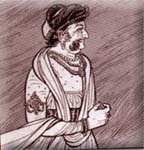 | He was the favourite of the kings, princes, palaces, Nawabs, Emperors and the cream of the society. As a connoisseur of good breed horses, and a trader of suchorses,he mediated between many kings and rulers and communities and settled their disputes and became famous all over India. He played sword fighting and made people play sword fighting. He gave donations of lacks. |
He supplied horses and ammunitions, cash, money and equipment to the Peshwas, Gaikwads, British and Nawabs. He arranged for pilgrimage to Badrivishal and Kedarnath. In the history of Kutch people like Fateh Mohamad, Sunderji Saudagar, Jagdusha Datar makes eyes sparkle. Service to humanity and the seekers of power are people like Mekan Dada, Kutch’s industrial fore father Ramsinh Malam and such people have in this period of 150 years shined in their own way.
The rising of the Swaminarayan Sect
The Swaminarayan sect starts with the ascendance of Swami Sahajanand. Kutch’s foremost army leader Fatehmohamad descended from his horse and touched the feet of Swami Sahajanand. His influence in Kutch Saurashtra and Gujrat and initially the Vaishnav thought process has now reached the entire globe. In Kutch this sect has made a difference in its social, economical and spiritual and other fields and taught them the glory of labor, valor, and the power of Shree and gave them a special life concept.
The beginning of British rule in Kutch
Rao Raydhan and Jamadar Fateh Mohamad died in a span of 25 days in the year 1813. In the next seven years under the leadership of Rao Bharmalji, the Union Jack of the British established itself on the soil of Kutch. Captain Mc Mardo set the British rule in Kutch. He made the Landlords of Kutch and their rulers agree to British rule. At this time there was one strong person whose name is Dewan Laxmidas Kamdar. Let us talk about the present history of Kutch in view of Deshalji. In 1819 the Company rule limited the powers of Kutch’s rulers by a treaty. They removed Bharmalji from the throne, and put Deshalji on the throne.
They put the British army in Kutch. They put the ports of Kutch to British use. They stopped the drinking of milk by Kshatriya new born girl children. They gave separate rule to the Jadejas and the landlords to give effect to their ‘Divide and rule’ policy. After removing Bharmalji from the throne, the Child king Deshalji’s name was used but actually the Regency Council ruled the state under the leadership of a British resident. Cow slaughter and peacock killing were banned in Kutch. |  |
The trade of Kutch, Sea trade, Industries and agriculture got a very big setback during British interference but later the same got stabilized. Deshalji although 18 years of age took the management of law in his own hands. The trade with Africa especially Zanzibar improved significantly. Slowly and steadily the industrialization in Kutch got a set back which was started by Lakhpatji and Godji.
The touch of modernization in Kutch
After Deshalji, when Pragmalji II came to power, the trend of state funded education started. The civil and army laws were framed and from 1860 to 1875 his rule came to an end. In the meanwhile modernization set foot in Kutch with the appointment of Non Kutchi Dewan Dewan Bahadur Krishnaji Tulkar, Police Commissioner Pandurang Shivram, and as the Chief Justice Shri Vinayakrao Bhagwat.
 | Uptil now only Kutchis were appointed on key positions but under the guidance of British this change came to be implemented. The glory of the Kutchi Maharao was kept intact inspite of British supervision. The time of Pragmalji means High Schools, Libraries, Prag Mahal a type of Gothic and Italian Palace, Port Police, Special cell for minerals, Forest officers for forest protection. The first Bhuj Municipality was formed at that time only. |
Khengarji III and the feel of freedom
After Pragmalji able rule was given by Sir Khengarji. In his time i.e. 1876 for a long period of time National freedom struggle could be felt in Kutch also.
Not only in Kutch but also outside Kutch in Bombay, in 1926 Late Shri Shoorji Vallabhdas’ first session, in 1927 in Mandvi Shri Laxmidas Ravji Tershi, in 1930 in Anjar Mr Yakub Hussain, in 1934 Shri Mulraj Karsandas, in 1937 Shri Biharilal Naranji Antani and In Mundra Yusuf Meheralli and in Bhuj and Koday Shri Gulabshankar Amrutlal Dholakia’s presidentship in 1945 and 1948 Conferences were held. In 1938 in Kutch Young Workers Union came into being. | 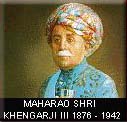 |
The Indian National Conference made various demands before the ruling Council. In these days Jawaharlal Nehru also came forward before the nation’s ruling provinces to fight against the British.
The able leadership of Yusuf Meheralli
As such this people’s awakening was mainly due to the able leadership of Biradar Yusuf Meheralli. A bachelor and an academic scholar and having complete faith in democratic values, Yusuf Meheralli went to each and every village of Kutch and pressed for a responsible government. He took straight steps against Sir Khengarji’s rule and threatened of non violent struggle. This period of 1938 was the period of people’s awakening and their enthusiasm. The aura and strength shown by the youth of Kutch at that time, its color will never fade.
From 1876 to 1942, Sir Khengarji ruled single handedly and during that time 139 landlords were divided into four parts and given recognition for more or less distribution. In the entire Kutch tree felling was banned and even grass cutting was stopped. In this way Sir Khengarji has done the right thing overlooking today’s policy of modern culture, and quick gains.
When Kutch was joined in the Union of India, Sardar Vallabbhai Patel has said that if you want to see two hundred years of tradition you should see it in Kutch which has remained untouched by the modern world.Sir Khengarji : Comparison with present arrangement.
Sardar was right. After his tour of 1925, Gandhiji had also remarked that there are no motorable roads in Kutch. Railway is even less. Villages were difficult to access. One should think of the treasury of that time. Today in the name of progress, State Govts., Corporations, Panchayats and Municipalities are levying huge taxes and enjoying at the cost of the common man.
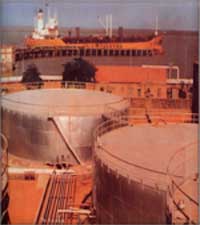 | With limited resources, name sake taxes, 139 guarantee holders landlords divided have taken initiatives to improve agriculture. Kandla Tuna to Bhuj railway line is laid. To select the Kandla Port they went on horsebacks and camels. Today the Kandla Port is ready and it was seen that sweet water is got from the Vadi village. This programme is effective even today. When Sir Khengarji started this in 1930, sixty five years have passed since. |
In the first five year plan since 1956 in the first eight years for the development of Kutch out of Rs. 3,24,78000 Rs. 2,86,70000 were released. In the next figures they touch millions and billions but in return what has been achieved is break down of dams, break down of bridges in every rain, defective walls, cracking plasters, etc. Inspite of good rains, the position is that of draught and or semi draught.
Strict evaluation of History necessary
It does not mean that Maharao Khengarji’s rule was ideal, his speed was proper and his approach was always flawless. From 1901 to 1950 there was no rainless year. The slow policy of Khengarji was in tune with Gandhiji’s slow policy.
 | After the death of Sir Khengarji, his successors Maharao shri Vijayrajji and Madansinhji finished the Jadeja rule in thier short span of power. Kutch was joined in the Union of India in 1948. After that Kutch was given K status and the Chief Commissioner became the ruler. |
The history is before us
As the last ruler of Kutch Shri Madansinhji was very close to Jawaharlal Nehru and he became the Ambassador to Norway representing the huge Kutch ruling family. In 1962 his brother Shri Himmatsinhji became the member of the Lok Sabha representing the Kutch community.
Party change : Intellectual symbol
Kutch has with the world and especially with Europe directly and indirectly fought with destructive forces. In the time of Jawaharlal Nehru, Rajgopalachari defied the congress policies of economics and free market and made his own independant party. This party got immense response in Kutch and all the constituences in 1962 be it Rajya Sabha and Lok Sabha got good response from the people. In this wave of anti congress, late Gulabshankar Amrutlal Dholakia left congress and won with a majority as an independant candidate.
Beginning of the process of Political degradation
The political history of Kutch and its speed look strange. The destiny of Kutch is sometimes an ant and sometimes like a lion. A semi-independant state at one time, becomes a state of Central rule, Premji Bhavanji Thakkar and Jamiyatrai Gulabshankar Vaidya become Chief and Deputy Chief
Ministers and advisors to Chief Commissioner and in 1956 Kutch becomes a part of Mumbai and becomes its one of the District and late Premji Bhavanji becomes the Chief Minister. In 1960, when the Gujrat state came into existence, Premjibhai alone is taken and that also as the Chief Minister of Gujrat. |
This was the beginning of the political degradation in Kutch. From 1960 to 1967 leaving aside Premjibhai, Navinbhai Shastri became Cabinet Cheif in 1985.
This degradation of Kutch was stopped by the strong voice of late Dr. Mahipatrai Moolshankar Mehta who as an M.P. evoked the clause 371 (2) for Kutch against the Centre and against his own party, the Congress Party. His dream to bring the Kutchis of the World together in Mumbai was defeated by the sudden demise of the Governor of Mumbai, Shri Ali Yavar Jung. The Order of Indira Gandhi for an independant Kutch Vikas Board was revoked by the late Morarji Desai. Dr Mehta as a leader of the Gujrat Pradesh Congress Committee was the first leader to be elected to this post. But due to internal strife he had to leave this post as well as his Congress membership and he had to start a new party in the name of Gujrat Rashtriya Congress which became a state party in 1982.
A sea change in 1975 – Kundanbhai as president.
In 1975 Gujrat witnessed its first non congress government and ShriKundanlal Jaswantlal Dholakia became the Speaker.
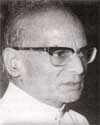 | That also because of non congress rule. In return, the 100 days old congress rule gave the post of chief to Shri Harilal Nanji Patel. Kutch could get only a symbolic importance. Ramji Raghavji Thakkar could not become more than a Deputy. |
It is significant to note that from 1985 to 1989 out of the six Vidhan sabha seats five seats went to the congress. Shri Shastri once again became cabinet chief for two months in Madhavsinh cabinet and in the end in 1992 in the cabinet of Chimanbhai.
Miracle in 1995 – Sureshbhai as Chief Minister.
In 1990 the rule of Janta Dal and B J P Combine came, and Shri Chimanbhai Patel became the Chief Minister and Shri Sureshchandra Roopshankar Mehta became the Industries minister of Gujrat. This government appointed
Shri Narendrasinh Jadeja as the Wool and Sheep Minister who was the first Kutchi chief to head this post and Dr Nimaben Bhavesh Acharya was made the state’s chief of Women’s Economic Development Nigam. These two were from the non ruling party. |
Political representatives.
Since 1956 till today the important people who matter in the Kutch history are late Premjibhai Bhavanji Thakkar, late Smt. Trilochanaben Ushakant Dholakia, late Zhumakhlal Mehta, Shri Jamiyatrai Gulabshankar Vaidya, Shri Kundanlal Jaswantlal Dholakia, late Gulabshankar Amrutlal Dholakia, late Jadavji Raghavji Morbia, late Premchand Morbia, late Naushir Dastur, Shri Virji Bhimji Dafda, late Dr Mahipatrai Mehta, Shri Mulji Purshottam Thakkar, Shri Bhupendrasinhji Jadeja, Shri Madhavsinhji Mokaji Jadeja, Shri Khimji Nagji Patel, Shri Kanubha Madhubha Jadeja, Smt. Nirmalaben Gajwani, Shri Harilal Nanji Patel, Shri Sureshchandra Roopshankar Mehta, Shri Maheshbhai Harjivan Thakkar, Shri Champaklal Chunilal Shah, Professor Nemji Kenia, Shri Jaykumar Sanghvi, Shri Kharashankar Vithaldas Joshi, Shri Mohanlal Nemchand Shah, Shri Kumudiben Pancholi, Shri Navinbhai Shastri, Shri Babulal Meghji Shah, Shri Khimjibhai Jesang, Shri Meghjibhai Motharia, late Harirambhai Kothari, Shri Valjibhai Danecha, Shri Parbatbhai Sodham, Shri Tarachandbhai Chheda, Shri Mohanlal Nemchand Shah, Shri Pushpdanbhai Gadvi, Shri Mukeshbhai Zaveri and Smt. Neemaben Acharya.
Late Premji Bhavanji, Shri Virji Bhimji Dafda, Shri Sureshchandra Mehta, Shri Harilal Nanji Patel, Shri Meghjibhai Motharia, Navinbhai Shastri, Kundanlal Dholakia, Parbatbhai Sodham and Shri Khimjibhai Jesang were elected to the Vidhan Sabha for more than once. They were elected from different parties such as Congress, Independants, Janta Morcha and B J P.
The Legislative Council and Kutch.
In India’s Council, late Bhavanjibhai Arjan Khimji represented Kutch. Inspite of this an economic professor Shri K T Shah represented Mumbai in the Council. Professor K T Shah before independance helped Jawaharlal Nehru. Late K T Shah of Bhomka in Mandvi and revolutionery late Shyamji Krishnavarma have received recognition not only in India but abroad also. When this temporary council was made into a parliament, late Gulabshankar Amrutlal Dholakia was elected to the Lok Sabha on the recommendation of the Chief Commissioner. Shri Premji Bhavanji Thakkar was elected to the Council of States. In 1952 there were two seats for Kutch in the Lok Sabha. Later on the same was reduced to one and till today it is the same. To represent Kutch in the Rajya Sabha the credit goes to late Lavji Lakhamshi Thakkar, late Dr Mahipatrai Moolshankar Mehta and Shri Kishorbhai Mehta of the Congress. From the independants late Dr Biharilal Naranji Antani and of the B J P Shri Anantbhai Dave.
Before the start of Panchayat Rajya in Kutch, the District Local Board first chief Shri Hirjibhai Kotak was the head. Late shri Kantiprasad Chandrashankar Antani became the first chief of Kutch District Panchayat. After that late Moolshankarbhai Kunvarji Gaur, Shri Jethmalbhai Vishanji Madaiyar, Shri Shivdasbhai Govind Patel, Shri Veljibhai Bijal Humble enjoyed the post. Today Shri Gopalbhai Dhuva is the present chief.
In 1965 Kutch bore the brunt of Pakistani Attack. In 1971 also the borders of Kutch were rocked by the same enemy. The Pakistani demand of Chhadbet resulted in giving away a part of Kutch due to the Hague Court. After all the turmoils and turbulences Kutch today relives as the princess of the 21 st century.
History of oswal caste and it's migration in kutch
The name oswal is derived from oayaspur or osnagarThis was developed by the son of king bheem of ujjainfrom parmaar generation,mori branch in the seventh century.As this city was in ujjain it was named oayaspur or osnagar.As time passed oswad city comprised of only paarkar ,sodha of uparkot, bhatti's of jesalmer and rathod of jodhpur.The main goddess worshipped by the people of this city is osiyadevi because she is the kuldevi of the king and shatriyas af osnagar.
After lord Mahavir in the vikram sawant 723 oogotan suriji gave his brilliant &capable students suripad in the maarwad region at bhinnamal nagar near vad village in the south direction under a vad tree,hence they were called vadgutchh.among these 84 suris, every suri got a particular gutch name which was named by the village they entered first while migrating.In this way vadgutchh branch has 84 gutch.
Bhinnamal nagar had seen a lot of ups and downs.According to the old scripts,in the year 1111 "Bodimugal",a muslim King had looted this nagar &destroyed it.
In the year 772 in the Shankeshwar gutch Acharya Udayprabhusuriji in Bhinnamal nagar addresed shrimali Brahman caste's 62 naqgar seth& pragvaah brahman caste's 8 seth.Hence Prabhanandsuriji student of Udayprabhusurijiwho addresed 70 villages acquired Suripad & his family was recognised as Nanakgutchh.(from the name Nanakpur).
In the nanakgutchh in the year 1133 Jaysinghsuriji gave Aacharyapad to Vijaychandra Upadhyay and alloted the name Aryarakshitsuriji and in this manner Aanchalgutchh was established.
In the Vallabhigutch in the year 1309 inthe 15th paat Aacharya Sinhprabhusuriji became the Aacharya of Aanchalgutchh. As a result Vallabhigutchh branch was over and that gutch's family was included in Aanchalgutchh(Vidhipakshgutchh).
After veerprabhu, 52 years later ,Ratnaprabhusuriji became Aacharya in Parasnathji's 6th paat in the upkesh gutchh. In the year 1222 he travelled in Marwaad where he addressed a lot shatriyas thereby creating anaffection for Jain religion.After that he came to Osnagar(osiya village). In this village he gathered whole Marwaad, Sindh, south Punjab, Mewad, Parkar region's Jain shatriyas.In these shatriyas among branches of parmaar,chauhan,solanki,etc 18 kuls were present from 36 rajkuls.From these Thakore,Sawant, Sardar, Patavat,etc, Thakur, Rav, Raval,Ravat designations were possessed.
Suriji gathered all these shatriyas and decided some common clauses.In these clauses various Aachar, Vyavhaar,traditions& cultures were included.The clause included all the programmes related to religion & of public interest.
In this manner the whole group of shatriyas was given the name as Oswad derived from the oswad region which was later named as "Oswal".
In this manner established oswal samaj's leaders established "'Mahajan-sangh's" in their own regions.Each sangh was recognised as "Oswal Mahajan Sangh".As new shatriyas came Oswal caste's population started increasing. [thanks; kachchh.webs.com]

